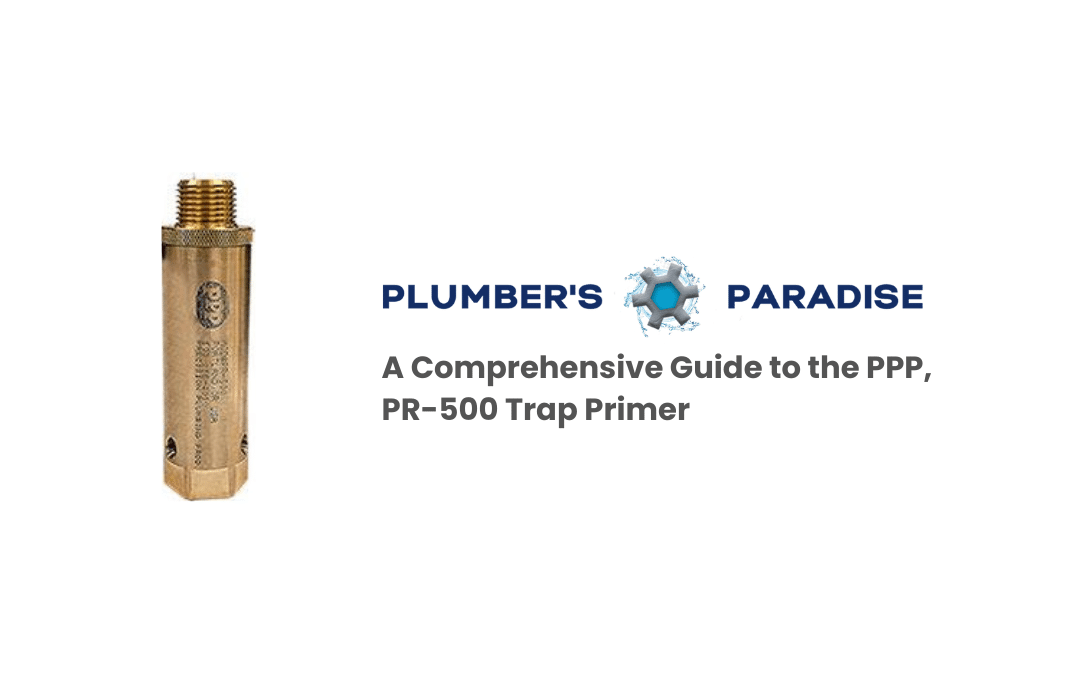In the world of plumbing, ensuring efficient drainage systems is crucial for maintaining clean and hygienic environments. One important component that plays a vital role in this process is the PR-500 Trap Primer. In this comprehensive guide, we will delve into the various aspects of the PR-500 Trap Primer, including its functionality, installation process, troubleshooting common issues, and maintenance tips. By the end of this guide, we hope you’ll have a firm understanding of this essential plumbing component and its significance in keeping your drainage systems in optimal condition.
Understanding Trap Primers
Before we explore the intricacies of the PR-500 Trap Primer, let’s take a moment to understand what a trap primer actually is.
A trap primer is a plumbing device that serves to replenish water in drain traps, which are located in various plumbing fixtures. Without a trap primer, the water in these traps can evaporate over time, rendering them ineffective.
What Are the Main Benefits of a Trap Primer?
- Preventing Odors: By maintaining the water seal in the trap, a trap primer helps prevent sewer gases from escaping into the building, which can cause foul odors and potentially be harmful to occupants’ health.
- Compliance with Building Codes: Many building codes and regulations require the use of trap primers in certain commercial or industrial settings to ensure proper sanitation and safety.
- Reduced Maintenance: Trap primers can reduce the need for manual maintenance of traps, as they automatically keep the traps filled with water. This can save time and effort for maintenance personnel.
- Preventing Drain Blockages: Adequate water levels in traps can help prevent debris from accumulating and causing blockages in drain lines.
- Improved Indoor Air Quality: By preventing sewer gas infiltration, trap primers contribute to a healthier indoor environment by maintaining better indoor air quality.
- Plumbing Efficiency: By keeping the traps filled with water, the primer contributes to smooth and uninterrupted water flow through the drains.
- Cost Savings: While there is an upfront cost to installing a trap primer, it can lead to cost savings over time by reducing the need for expensive repairs due to drain blockages or foul odor issues.
Trap primers, such as the PR-500, play a crucial role in maintaining the overall hygiene and well-being of a building. They are particularly important in commercial buildings, where the number of plumbing fixtures is significantly higher compared to residential properties. Without a reliable trap primer, the risk of sewer gases entering the building increases exponentially, posing a threat to the health and safety of employees, customers, and visitors.
Introduction: PR-500 Trap Primer
The PR-500 Trap Primer, in particular, is a top-of-the-line model designed by PPP (Precision Plumbing Products), a well established brand that manufactures its products in the USA, and operates out of Oregon in its focus to provide the plumbing community with durable parts.

Key Features & Benefits of the PR-500 Trap Primer
The PR-500 Trap Primer boasts an array of features that set it apart from other models on the market.
- Durable: This superior trap primer is constructed with durable materials to withstand the test of time.
- Reliable: With a reliable automatic valve mechanism, the PR-500 Trap Primer ensures consistent water flow to the traps, preventing any potential issues caused by dry traps.
- High Capacity: It can prime up to two floors drains with its patented distribution DU-U & DU-4 units.
- Affordable: Currently priced at $52.88 in the Plumber’s Paradise store.
Other Key Specifications
- fds
- System operating range: 20 psi minimum to 80 psi (138 to 552 kpa) maximum
- Valve pressure requirements: 3 psi (21 kpa) pressure drop to activate and deliver a metered amount of water to the floor drain
- Requirements of water supply: cold water only
- Lead Certified: NSF-372
- Constructed material: 693 brass, EPDM E70 O-rings, Dow #7 Silicone, #60 stainless steel mesh screen
Key Installation Notes for the PR-500 Trap Primer
Now that we understand the significance of a trap primer in plumbing systems, let’s explore some key installation notes.
Tools Needed for Installation
Before you begin installing the PR 500-Trap Primer, gather the necessary tools. These may include a wrench, pipe cutters, Teflon tape, and a hacksaw.
Step-by-Step Installation
- Flush line prior to installation.
- Use ribbon pipe seal tape – ONLY.
- Install valve plumb using caution to not over tighten. Tightening to more than 55ft.lbs. can damage valve and void the warranty. Do not tighten on hex.
- Effective operating range 20 to 80 PSIG (138 to 552 kpa).
- Must be installed near a fixture that creates a minimum of 3 PSIG pressure drop. Minimum discharge rate is .15ml per activation at 20 PSI. and .05ml per activation at 80 PSI.
- According to the Manufacturer, failure to follow these instructions will make the product warranty null and void.
Caution: Important Notes
- Primer requires no adjustments after installation.
- Cycle the primer at least five times to ensure proper use.
- The Trap Primer must be installed on a cold temperature water line of 1 1/2” dia. or less.
- Must be installed near a fixture that creates a minimum of 3 PSIG pressure drop.
- Do not install on water heater line due to insufficient pressure drop.
- Do not subject Trap Primer Valve to pressure in excess of 80 psi.
- All drain supply lines must be clear to assure proper discharge to trap. Failure to do so could result in water discharge through air gap port.
For further installation details, access the manufacture’s literature here.
Troubleshooting Common Issues with a Trap Primer
While a Trap Primer is designed to ensure seamless functionality, occasional issues may arise. Let’s explore some common problems that may occur and their respective solutions.
Identifying Common Problems
1. Insufficient water flow into traps.
2. Inconsistent water flow from the trap primer.
3. Leakage from the trap primer.
Troubleshooting Solutions for Typical Trap Primer Issues
1. Insufficient water flow into traps: Check for any blockages in the pipe or valve mechanism. Clean or replace any clogged components.
2. Inconsistent water flow from the trap primer: Adjust the valve mechanism to ensure a steady flow of water to the traps. If the problem persists, contact a professional plumber for assistance.
3. Leakage from the trap primer: Inspect the fittings for any loose connections. Tighten the fittings or replace any damaged parts to eliminate the leakage.
Maintenance Tips for the PR-500 Trap Primer
Now that your PR-500 Trap Primer is successfully installed and functioning optimally, let’s discuss some maintenance tips to ensure its longevity and efficient operation.
Routine Maintenance Procedures
1. Regularly inspect the trap primer for any signs of wear or damage. Replace worn-out components promptly to prevent any potential malfunctions.
2. Clean the trap primer periodically to remove any debris or sediment that may accumulate over time. Follow the manufacturer’s instructions for cleaning procedures.
3. Check the water flow into the traps of plumbing fixtures to ensure an adequate amount. Adjust the valve mechanism, if necessary, to maintain an optimal flow.
4. Keep an eye out for any abnormal odors or unusual noises that may indicate a potential issue. Address any problems immediately to prevent further damage.
Pricing and Purchasing
At the time of this posting, the PPP PR-500 is on sale for $52.88 on the PlumbersParadise storefront.
For Bulk Order Quotes and Shipping Time Estimates, contact us now at info@plumbersparadise.net


